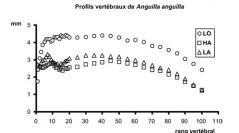

 Comptes Rendus Palevol
5 (3-4) - Pages 499-507
Comptes Rendus Palevol
5 (3-4) - Pages 499-507The biometrical study of length, height and width of the successive vertebrae constituting the vertebral axis of the eel (Anguilla anguilla), the rainbow trout (Oncorhynchus mykiss), the skipjack (Trachurus trachurus) and the bonite (Sarda orientalis) allows us to confirm that the axial skeleton shows a morpho-anatomical regionalization more complicated than the classical division in truncal and caudal parts only. With the morphological data reported here, it is possible to define four vertebral profiles that are different and characteristic of the four groups of axial swimming: anguilliform, subcarangiform, carangiform, and thunniform swimming (respectively exemplified by the eel, trout, skipjack and tuna). The relative rank of the maximal vertebral length, height and width according to body length of the fishes is characteristic of the axial swimming groups; close to the head in the anguilliform group, it is localized near the middle of the vertebral axis in the subcarangiform one and very posteriorly in the two last ones (carangiform and thunniform) that look relatively similar.
Teleostei, Vertebral axis, Morphofunctional regionalisation, Morphology, Swimming, Axial mode